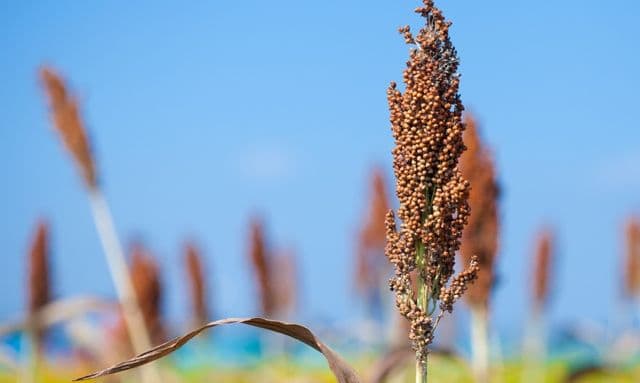The sweet sorghum plant, a variety of sorghum grass, is native to Africa. Today, it grows as a perennial in dry, warm places including India and the Southern United States. It also is cultivated as an annual in the Midwestern United States.
Though other varieties produce grain, farmers grow sweet sorghum for its stalk. Up to nine feet tall, the stalks consist of approximately 75 percent sugary juice and look similar to a corn crop. With folded, white, waxy leaves, sweet sorghum requires little rainwater—less than corn or sugarcane—and can survive hot temperatures. It grows quickly and is resistant to drought.
Sweet sorghum is a multi-purpose crop: it can be used to make syrup, paper, animal feed, and fuel. When processed properly, sweet sorghum leaves zero waste. It also has the potential to produce more ethanol than corn. Boiling the juice from the stem makes syrup; fermenting the juice creates ethanol; and the remaining pulp, or bagasse, may become paper or animal feed. Researchers looking for efficient fuel sources are especially interested in sweet sorghum because it can subsist on marginal soils and requires little water.
Sweet sorghum syrup is also a popular sweetener in India and a staple in the traditional cuisine of the Southern United States. Small farms in the region make molasses and syrup from sweet sorghum each year. Reedy Fork Farm in Elon, N.C., converted 75 gallons of sweet sorghum juice into nine gallons of molasses in 2013. Maintaining an old tradition on the farm, they use a 100-year-old sugar cane press to release the molasses
The syrup of sweet sorghum is also used in rum cocktails, as a maple syrup substitute with pancakes, and as a local sweetener in meat marinades for Southern-tinged dishes. One North Carolina beverage company, Fair Game, is distilling sorghum syrup to make a spirit called No’lasses, similar to rum.
Whether it’s just a trend in cooking or will become the next big fuel provider, sweet sorghum is grabbing the attention of innovators.













